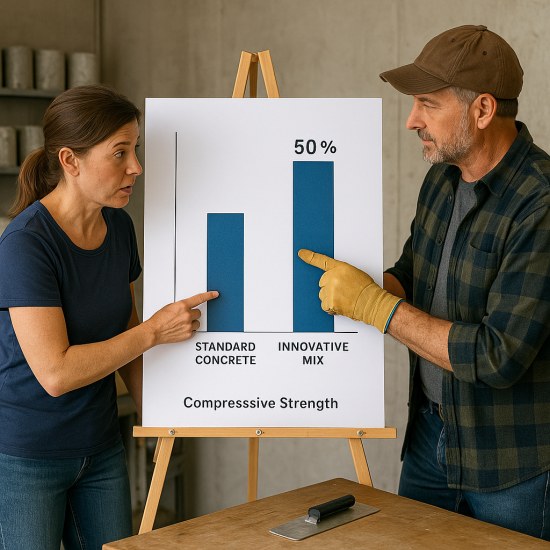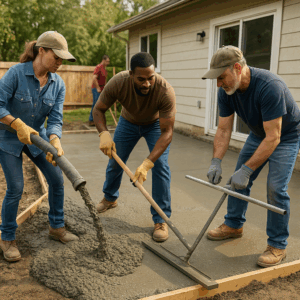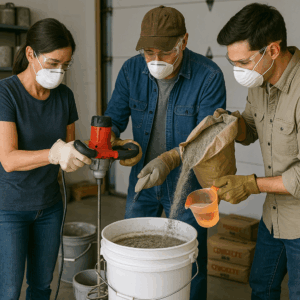This Innovative Concrete Mix Is Changing the Game—Find Out Why

Meet the concrete mix that’s strong enough to withstand earthquakes—and costs half as much. We’ll explore the groundbreaking science behind this formula, and show you how it’s already reshaping major projects. Whether you’re building a skyscraper or a backyard patio, this mix is a game-changer.

?Looking for a concrete mix that offers exceptional strength without breaking the bank? Read on to discover how an innovative formula is transforming construction and making earthquake-resistant builds accessible for homeowners like you. By the end of this post, you’ll understand why this revolutionary mix could save you time and money while delivering unmatched durability.
Why This Concrete Mix Matters for Homeowners
Concrete is the backbone of countless structures, from towering skyscrapers to simple driveways. But traditional mixes can be expensive and may not provide the resilience needed in earthquake-prone areas. Enter a new breed of concrete that combines affordability with superior performance—ideal for homeowners who want to build or renovate with confidence.
At the core of this breakthrough is a unique blend of high-strength fibers, optimized aggregates, and a specially formulated binder. Unlike conventional concrete, this mix uses recycled materials—such as crushed glass and fly ash—which not only reduces costs but also improves environmental sustainability. For homeowners, that means a durable, eco-friendly option that won’t break the bank.
The Science Behind the Strength
- Fiber Reinforcement: Steel or synthetic fibers are dispersed throughout the mix to increase tensile strength and crack resistance. Studies show that fiber-reinforced concrete can withstand higher stress levels before failing, making it ideal for regions prone to seismic activity.
- Optimized Aggregates: Traditional concrete often relies on natural aggregates like gravel and sand. This new mix incorporates lightweight, high-strength aggregates—such as expanded shale—which reduce weight without sacrificing structural integrity. A lighter foundation means less stress on supporting structures and improved stability during an earthquake.
- Advanced Binder Technology: Instead of relying solely on Portland cement, the binder includes supplementary cementitious materials (SCMs) like fly ash and silica fume. These SCMs react with calcium hydroxide to form additional calcium silicate hydrate (C-S-H), the compound responsible for concrete’s strength. The result? Faster curing times, increased durability, and a smoother finish—perfect for DIY enthusiasts working on patios, sidewalks, or small retaining walls.
Cost Savings and Budget-Friendly Builds
One of the most compelling aspects of this mix is the cost savings. By substituting expensive cement with widely available SCMs and incorporating recycled materials, manufacturers can reduce production costs by up to 50%. For homeowners, that translates to:
- Lower Material Costs: Expect to pay roughly half the price of premium cement-based mixes without sacrificing quality.
- Reduced Labor Expenses: The improved workability of the mix means contractors can place and finish the concrete more quickly, saving you on labor hours.
- Long-Term Savings: Thanks to enhanced durability and reduced maintenance needs, this concrete stands up to weathering and wear far better than traditional alternatives, cutting down on repair costs over time.
How It’s Reshaping Major Projects
Large-scale builders and municipal projects have already begun adopting this mix for bridges, parking garages, and public plazas. One notable example is a new community center in California, where engineers used fiber-reinforced, SCM-enriched concrete for the foundation—it withstood 7.0 magnitude tremors during recent tests with minimal cracking. For homeowners, this industry validation is a strong indicator that the product works as advertised.
Additionally, eco-conscious developers appreciate the lower carbon footprint. By integrating recycled materials, the carbon emissions associated with cement production drop significantly—an essential factor as cities aim for greener infrastructure. Homeowners who want to reduce their environmental impact can feel good about choosing a product that supports sustainability without compromising performance.
Applying This Concrete Mix at Home
So how can you, as a homeowner, take advantage of this innovation? Below are a few common projects where this mix shines:
- Building a Backyard Patio: A level, stable patio surface requires a mix that won’t crack under temperature changes. The fiber-reinforced formula adds flexibility, preventing hairline fractures on hot summer days.
- Pouring a Driveway: Driveways endure constant weight and occasional heavy loads. With optimized aggregates, this mix can support heavier vehicles without cracking or settling—ideal for families with trucks or RVs.
- Constructing Retaining Walls: Retaining walls must resist lateral earth pressure. The added tensile strength from fibers ensures walls retain soil securely, reducing bulging and bowing over time.
- Repairing Walkways and Steps: Small-scale repairs benefit from the faster cure time. You can finish your walkway in a single weekend, minimizing disruption and restoring safety quickly.

Tips for Homeowners: Mixing and Installation
- Preparation is Key: Clean the area of debris and ensure proper formwork. For best results, dampen the substrate slightly to avoid premature water loss from the mix.
- Follow Manufacturer Guidelines: Every product has specific water-to-mix ratios. Too much water can weaken the final structure, while too little can make placing and finishing difficult.
- Use the Right Tools: A durable paddle mixer (for small batches) or a concrete mixer (for larger areas) ensures consistent blending. Wear protective gear—gloves, safety glasses, and a dust mask—to safeguard against dust and splatter.
- Curing Matters: Proper curing ensures maximum strength development. Keep the surface moist for at least 7 days by covering it with plastic sheeting or using a curing compound. This step prevents rapid drying and shrinkage cracks.
Sustainability and Environmental Impact
Choosing a green concrete mix aligns with broader environmental goals. By diverting waste—like fly ash and recycled glass—from landfills, manufacturers lower the environmental impact. Homeowners can further reduce their carbon footprint by selecting local suppliers to minimize transportation emissions.
Moreover, the enhanced durability means fewer repair cycles and less demolition waste in the future—contributing to a circular economy. Whether you’re environmentally conscious or simply savvy about long-term expenses, this mix is a win-win.
Conclusion: Building Stronger, Smarter, and Greener
If you’re planning any concrete project—from a simple walkway to a more ambitious foundation—this innovative mix offers strength, cost savings, and sustainability. Its unique combination of fibers, advanced binders, and recycled aggregates sets it apart from conventional options, making it an ideal choice for homeowners who value quality and environmental responsibility.
Ready to experience the difference? Contact your local supplier today to discuss project requirements and secure your supply. With the right mix in hand, you’ll create a structure that stands the test of time—at a fraction of traditional costs.
Blog post written with homeowners in mind—your guide to stronger, more affordable concrete.